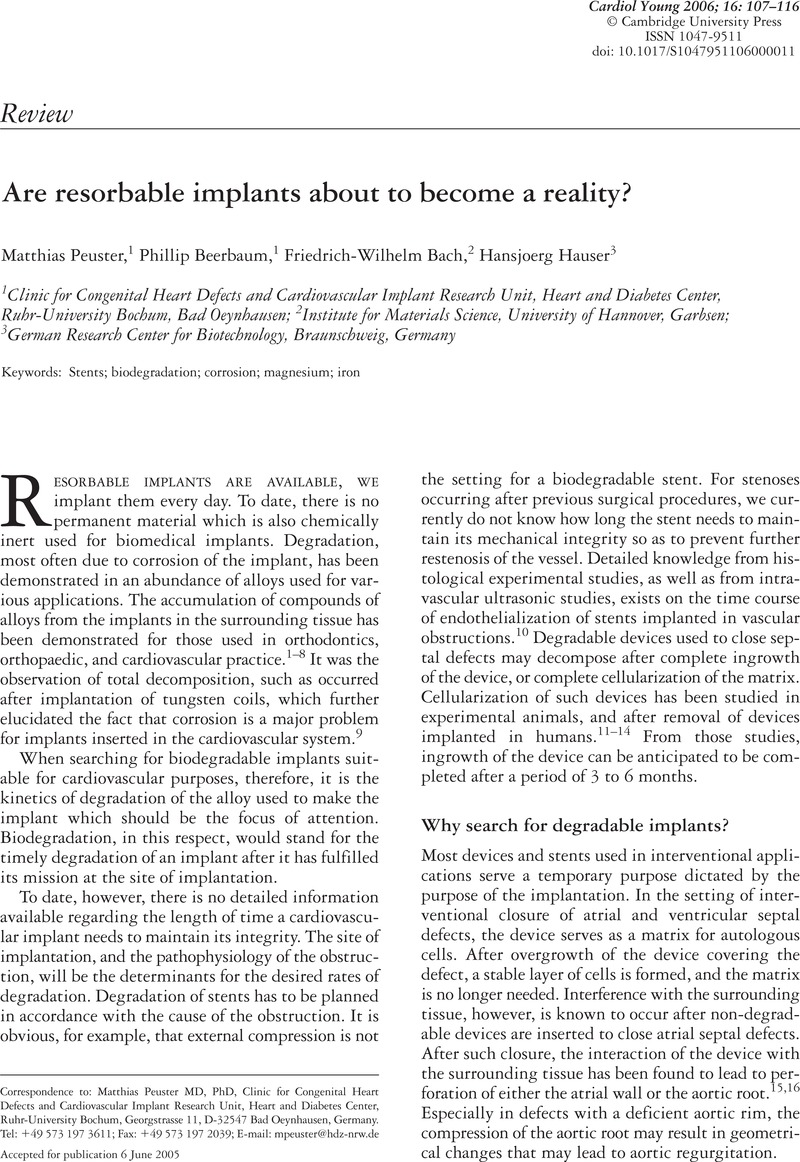Crossref Citations
This article has been cited by the following publications. This list is generated based on data provided by Crossref.
McMahon, Colin J.
Oslizlok, Paul
and
Walsh, Kevin P.
2007.
Early restenosis following biodegradable stent implantation in an aortopulmonary collateral of a patient with pulmonary atresia and hypoplastic pulmonary arteries.
Catheterization and Cardiovascular Interventions,
Vol. 69,
Issue. 5,
p.
735.
Gu, X N
Zheng, Y F
and
Chen, L J
2009.
Influence of artificial biological fluid composition on the biocorrosion of potential orthopedic Mg–Ca, AZ31, AZ91 alloys.
Biomedical Materials,
Vol. 4,
Issue. 6,
p.
065011.
Fekry, A.M.
and
El-Sherif, Rabab M.
2009.
Electrochemical corrosion behavior of magnesium and titanium alloys in simulated body fluid.
Electrochimica Acta,
Vol. 54,
Issue. 28,
p.
7280.
Gu, Xuenan
Zheng, Yufeng
Cheng, Yan
Zhong, Shengping
and
Xi, Tingfei
2009.
In vitro corrosion and biocompatibility of binary magnesium alloys.
Biomaterials,
Vol. 30,
Issue. 4,
p.
484.
Ghoneim, A.A.
Fekry, A.M.
and
Ameer, M.A.
2010.
Electrochemical behavior of magnesium alloys as biodegradable materials in Hank's solution.
Electrochimica Acta,
Vol. 55,
Issue. 20,
p.
6028.
2010.
Biomaterialien und Biokompatibilität.
Biomedizinische Technik/Biomedical Engineering,
Vol. 55,
Issue. s1,
p.
1.
Seuss, F.
Seuss, S.
Turhan, M. C.
Fabry, B.
and
Virtanen, S.
2011.
Corrosion of Mg alloy AZ91D in the presence of living cells.
Journal of Biomedical Materials Research Part B: Applied Biomaterials,
Vol. 99B,
Issue. 2,
p.
276.
Schumacher, Stephan
Stahl, Jessica
Bäumer, Wolfgang
Seitz, Jan-Marten
Bach, Friedrich-Wilhelm
Petersen, Lars J.
and
Kietzmann, Manfred
2011.
Ex Vivo Examination of the Biocompatibility of Biodegradable Magnesium via Microdialysis in the Isolated Perfused Bovine Udder Model.
The International Journal of Artificial Organs,
Vol. 34,
Issue. 1,
p.
34.
Seitz, Jan‐Marten
Collier, Kelly
Wulf, Eric
Bormann, Dirk
and
Bach, Friedrich‐Wilhelm
2011.
Comparison of the Corrosion Behavior of Coated and Uncoated Magnesium Alloys in an In Vitro Corrosion Environment.
Advanced Engineering Materials,
Vol. 13,
Issue. 9,
Erdmann, Nina
Angrisani, Nina
Reifenrath, Janin
Lucas, Arne
Thorey, Fritz
Bormann, Dirk
and
Meyer-Lindenberg, Andrea
2011.
Biomechanical testing and degradation analysis of MgCa0.8 alloy screws: A comparative in vivo study in rabbits.
Acta Biomaterialia,
Vol. 7,
Issue. 3,
p.
1421.
Huehnerschulte, Tim Andreas
Angrisani, Nina
Rittershaus, Dina
Bormann, Dirk
Windhagen, Henning
and
Meyer-Lindenberg, Andrea
2011.
In Vivo Corrosion of Two Novel Magnesium Alloys ZEK100 and AX30 and Their Mechanical Suitability as Biodegradable Implants.
Materials,
Vol. 4,
Issue. 6,
p.
1144.
Di Virgilio, Ana L.
Reigosa, Miguel
and
de Mele, Monica Fernández Lorenzo
2011.
Biocompatibility of magnesium particles evaluated by in vitro cytotoxicity and genotoxicity assays.
Journal of Biomedical Materials Research Part B: Applied Biomaterials,
Vol. 99B,
Issue. 1,
p.
111.
Salunke, Pravahan
Shanov, Vesselin
and
Witte, Frank
2011.
High purity biodegradable magnesium coating for implant application.
Materials Science and Engineering: B,
Vol. 176,
Issue. 20,
p.
1711.
Wang, Yongsheng
Lim, Chu Sing
Lim, Chao Voon
Yong, Ming Shyan
Teo, Eng Kiong
and
Moh, Law Ngai
2011.
In vitro degradation behavior of M1A magnesium alloy in protein-containing simulated body fluid.
Materials Science and Engineering: C,
Vol. 31,
Issue. 3,
p.
579.
Guslitzer-Okner, Regina
and
Mandler, Daniel
2011.
Applications of Electrochemistry and Nanotechnology in Biology and Medicine I.
Vol. 52,
Issue. ,
p.
291.
Virtanen, Sannakaisa
2011.
Biodegradable Mg and Mg alloys: Corrosion and biocompatibility.
Materials Science and Engineering: B,
Vol. 176,
Issue. 20,
p.
1600.
Hermawan, Hendra
and
Mantovani, Diego
2011.
New generation of medical implants: Metallic biodegradable coronary stent.
p.
399.
Moravej, Maryam
and
Mantovani, Diego
2011.
Biodegradable Metals for Cardiovascular Stent Application: Interests and New Opportunities.
International Journal of Molecular Sciences,
Vol. 12,
Issue. 7,
p.
4250.
Jamesh, M.
Kumar, Satendra
and
Sankara Narayanan, T.S.N.
2011.
Corrosion behavior of commercially pure Mg and ZM21 Mg alloy in Ringer’s solution – Long term evaluation by EIS.
Corrosion Science,
Vol. 53,
Issue. 2,
p.
645.
Hermawan, Hendra
2012.
Biodegradable Metals.
p.
23.





